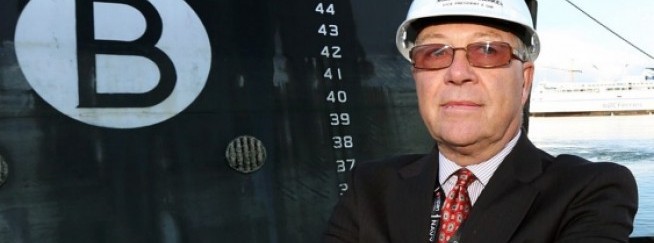Shipbuilding lifelong passion for SS Beaver Medal winner Malcolm Barker
Source: Times Colonist
Author: Carla Wilson
Published: November 19, 2013
Victoria Shipyards general manager Malcolm Barker’s “dream” phone call goes like this: “Mr. Barker, I have a problem. Can you help me?”
Barker delights in challenges. He’s had plenty during 50 years in the ship repair and shipbuilding industry, most of that leading Victoria Shipyards from infancy to maturity at Esquimalt Graving Dock. The company was formed after century-old Yarrows Shipyards folded and at a time when the industry’s future was in doubt.
Barker, who is planning to retire next year, has always been passionate about big ships. “Every day it’s a different problem and a different challenge.”
B.C. Lt.-Gov. Judith Guichon is presenting Barker with the Maritime Museum of British Columbia’s prestigious SS Beaver Medal today. The Hudson’s Bay Company’s Beaver was the first steamship to operate in the Pacific Northwest.
“B.C.’s ocean economy contributes about eight per cent of province’s gross domestic product and the Beaver Medal is intended to spotlight people who helped create or chronicled this activity,” said Jan Drent, who headed the museum’s selection process.
The museum points to Barker’s “dynamic leadership” in establishing Victoria Shipyards’ reputation for quality work in new construction, ship upgrades and repair.
On Tuesday, about 800 workers were on the job for Victoria Shipyards, owned by North Vancouver-based Seaspan Marine, also owner of Vancouver Shipyards. Barker is pleased to see that number of workers at the yard, knowing it not only spells success for Seaspan but gives employees steady work and wages spent in the local economy.
Born to a coal-mining family in northeastern England, Barker left school at age 15 to apprentice as an electrician at a shipyard, taking further training in the technical office, and in contracting and estimating. In May 1974, a colleague convinced Barker to join in an adventure to work at the Halifax shipyard. After a year, Barker and his wife, Carol, who now have two adult children, headed west to spend a couple of years as a electrical design draftsman for Burrard Drydock in Vancouver.
They returned to the U.K. in 1977, but were lured to San Diego, Calif., where Barker worked in the design office at Nassco shipyard. After a year and half in California, Burrard Drydock called when it had large B.C. Ferries projects and Barker returned to B.C. for good.
In 1980, Barker moved to Victoria to join Yarrows, where he served as assistant new-construction superintendent. Vessels built include the Canadian Coast Guard’s George R. Pearkes, a light icebreaker and large buoy tender. Barker went into estimating and, in 1988, became the project manager for HMCS Endeavour’s mid-life refit.
However, Yarrows was in trouble and eventually closed. Barker was asked by Seaspan to set up a ship repair division at the graving dock. A small grey container sits outside Barker’s office, bearing the original company name of Vancouver Shipyard (Esquimalt) Ltd., established April 27, 1994.
That company started with an experienced five-member management team and with union workers, who agreed to a new collective agreement. Equipment was purchased from Yarrows. “We worked extremely hard,” Barker said. There was “lots of midnight oil burned to get up and running.”
Barker praises the workforce. He had an open-door policy for workers and climbed through ships to understand what is required to do a job. “You’ve got to be empathetic. You’ve got to spend time in people’s shoes.”
The shipyard’s first contract was for $17,000. Now it is not uncommon to see multi-year contracts worth hundreds of millions.
About 90 per cent of Victoria Shipyards’ management team has come up from the shop floor, he said.
Barker is optimistic about the future of shipbuilding, pointing to federal contracts, LNG and proximity to the naval base.



Site design by Ravensfoot